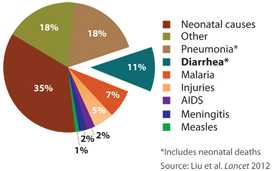Disease & SWS Impact

Diarrhea kills more children than malaria, measles, and AIDS combined. Proportional distribution of cause-specific deaths among children under five years of age, 2012 (excluding neonatal deaths). 2
Since 1990, 2 billion people have gained access to improved drinking water sources and 1.8 billion people have gained access to improved sanitation. However, worldwide, 780 million people still do not have access to improved water sources and an estimated 2.5 billion people — half of the developing world — lack access to adequate sanitation 1. Approximately 88% of deaths due to diarrheal illness worldwide are attributable to unsafe water, inadequate sanitation and poor hygiene 2. Diarrheal diseases (such as cholera) kill more children than AIDS, malaria, and measles combined, making it the second leading cause of death among children under five 2.
The pathogens that cause diarrhea are commonly spread by food or water that has been contaminated with human or animal feces. This contamination can occur in the environment as a result of inadequate sanitation and inadequate protection of drinking water sources and food products, or in the home through unsafe water storage and inadequate hygiene.
Diarrhea is not the only disease spread through unsafe water and poor sanitation and hygiene practices. Neglected tropical diseases like schistosomiasis and Guinea worm disease can be reduced almost 80% with improved hygiene, sanitation, and safe water access 3. In fact, access to safe water and improved hygiene and sanitation has the potential to prevent at least 9.1% of the global disease burden and 6.3% of all deaths 4.
To address this global issue, CDC and the Pan American Health Organization (PAHO) developed the Safe Water System (SWS), which protects communities from contaminated water by promoting behavior change and providing affordable and sustainable solutions. The SWS increases access to safe water by helping individuals to sustainably treat and safely store water in homes, health facilities, and schools.
The SWS encompasses three steps:
- Household water treatment;
- Safe storage of the treated water; and,
- Behavior change communications to improve hygiene, sanitation, and water and food handling practices.
References
- World Health Organization and UNICEF. Progress on Drinking Water and Sanitation: 2012 Update. United States: WHO/UNICEF Joint Monitoring Programme for Water Supply and Sanitation; 2012.
- Liu L, Johnson HL, Cousens S, Perin J, Scott S, Lawn JE, Rudan I, Campbell H, Cibulskis R, Li M, Mathers C, Black RE; Child Health Epidemiology Reference Group of WHO and UNICEF. Global, regional, and national causes of child mortality: an updated systematic analysis for 2010 with time trends since 2000. Lancet. 2012;379(9832):2151-61.
- Esrey SA, Potash JB, Roberts L, Shiff C. Effects of improved water supply and sanitation on ascariasis, diarrhea, dracunculiasis, hookworm infection, schistosomiasis, and trachoma. Bull World Health Organ. 1991;69(5):609-21.
- Prüss-Üstün A, Bos, R, Gore F, Bartram J. 2008. Safer water, better health: costs, benefits and sustainability of interventions to protect and promote health [PDF – 60 pages]. World Health Organization, Geneva.
- Page last reviewed: April 16, 2014
- Page last updated: May 2, 2014
- Content Source:


 ShareCompartir
ShareCompartir